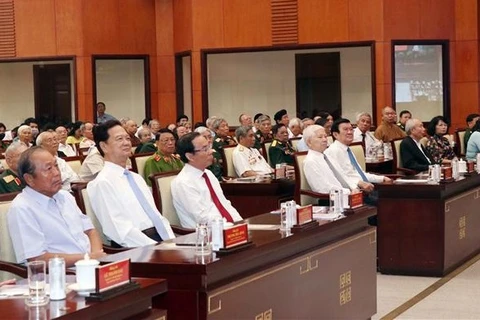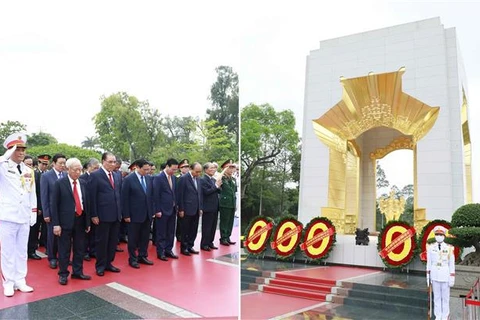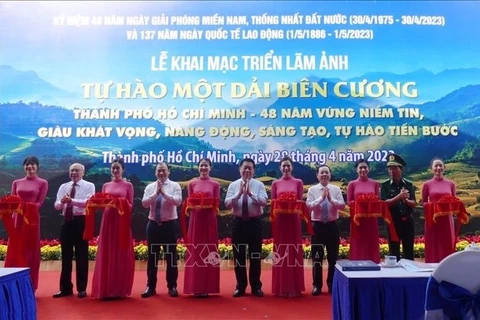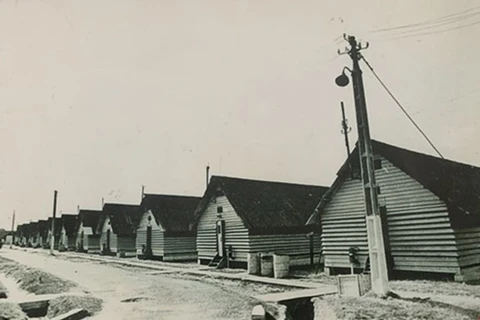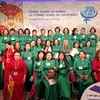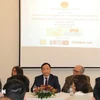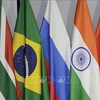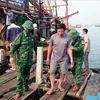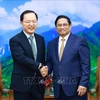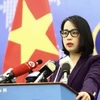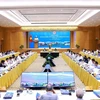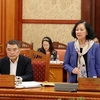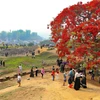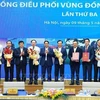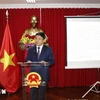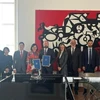Hanoi (VNA) - The resistance war against the US from 1954 to 1975 was the longest and fiercest fight in the history of struggling with foreign invaders in Vietnam.
Over the 21 years of fighting, Vietnam defeated the new-style invasive war waged by the US imperialists to completely liberate the South and reunify the country. That feat of arms was a brilliant symbol of the revolutionary heroism and human wisdom and went down in history as a great victory of the 20th century and a significant event of international importance.
That great victory was attributed to the harmony of many factors, the most decisive of which was the clear-sighted and creative leadership of the Communist Party of Vietnam.
Party sets up appropriate guidelines, measures, forms of struggle
After the Geneva Accords on Ending the War and Restoring Peace in Indochina was signed, facing the US imperialists’ intention to replace France and invade South Vietnam, at the sixth session of the 2nd-tenure Party Central Committee in July 1954, the Party identified that the main enemy of the global people that was becoming the main and direct enemy of the Indochinese people was the US imperialists.
Following the resolution of the 15th session of the 2nd-tenure Party Central Committee in January 1959, a force that comprised three types of troops (the regular army, local soldiers, and militia and guerrillas) and a system of military commands at different levels gradually took shape. The National Front for the Liberation of South Vietnam was set up. Revolutionary bases were also recovered and expanded.
 Lawyer Nguyen Huu Tho, Chairman of the Central Committee of the National Front for the Liberation of South Vietnam, reviews the guard of honour of a unit of the liberation armed forces of South Vietnam in 1960. (Photo: VNA)
Lawyer Nguyen Huu Tho, Chairman of the Central Committee of the National Front for the Liberation of South Vietnam, reviews the guard of honour of a unit of the liberation armed forces of South Vietnam in 1960. (Photo: VNA) In September 1960, the third National Party Congress completed the revolutionary line of Vietnam. The Party identified and pointed out the country’s new enemy, which was the US imperialists and their henchmen. It judiciously outlined two revolutionary strategies, which were to quickly stabilised the situation and to consolidate the North as the solid rear and the leadership centre for the revolution nationwide. The Party also devised beneficial guidelines and measures of the revolutionary struggle, and properly handled the relationship between the liberation of the South and socialism building in the North, as well as the Vietnamese revolution and the international one.
The Party also converted the revolutionary struggle in the South from partial uprisings to a revolutionary war in a timely manner, and cleverly combined armed uprisings with revolutionary warfare. It also aligned the fight of the southern people with the new situation, and fought the enemy in terms of both military and politics, on three prongs (military, politics, and proselytisation), and in all the three strategic areas (mountainous, rural, and urban areas).
Thanks to that, Vietnam managed to thwart the “Special War” strategy of the US and its puppet government, forcing the US to shift to the “Local War” strategy.
 The third National Congress of the Vietnam Workers’ Party (a former name of the Communist Party of Vietnam) from September 5 to 10, 1960 in Hanoi. (Photo: VNA)
The third National Congress of the Vietnam Workers’ Party (a former name of the Communist Party of Vietnam) from September 5 to 10, 1960 in Hanoi. (Photo: VNA) Specifying strategic tasks of the North and South
Right in July 1954, the Party determined that the North must be built into the revolutionary base of the whole country. At the 7th session of the 2nd-tenure Party Central Committee in March 1955, the tasks for the two regions were further clarified. The North held the most decisive role in the entire cause of the South liberation and national reunification, while the South played the direct role in toppling the rule of the US imperialists and their henchmen to free the South and reunify the country to complete the people’s national democratic revolution.
At the 13th session of the 2nd-tenure Party Central Committee in December 1957, the Party and President Ho Chi Minh issued the guidelines for concurrently implementing the two revolutionary strategies. These were the people’s national democratic revolution in the South and the socialist revolution in the North. In particular, the consolidation of the North towards socialism played the decisive role in the revolution’s success in the new period, and the revolutionary force in the South needed to be maintained and further developed. The Party considered this the direct and decisive factor of the victory of the struggle for the South liberation and national reunification.
 The National Front for the Liberation of South Vietnam was established in the liberated zone in Tan Lap commune of Chau Thanh district (now Tan Bien district of Tay Ninh province) on December 20, 1960. (File photo: VNA)
The National Front for the Liberation of South Vietnam was established in the liberated zone in Tan Lap commune of Chau Thanh district (now Tan Bien district of Tay Ninh province) on December 20, 1960. (File photo: VNA) The position of each region in the revolution continued to be affirmed at the third National Party Congress in September 1960.
The reality proved that the close bonds between the two regions in the revolution created invincible strength. The North invested all-out strength of the socialist regime into the fight and excellently fulfilled its duty as the revolutionary base of the entire country. Meanwhile, under the Party’s leadership, people in the South showed their direct and decisive role in defeating the US imperialists and henchmen, creatively implemented the Party’s revolutionary line, surmounted every challenge, and invented many efficient fighting methods.
Making accurate predictions
The Party and President Ho Chi Minh also made early and precise predictions of the war’s developments to issue right, proactive, and creative response policies.
The Party did not choose forest, mountainous, or rural areas as the direction for attacks but cities, especially Saigon, Da Nang and Hue, which were weak spots of the enemy. It also forecast possible scenarios and decided to launch the 1968 Spring General Offensive and Uprising. That reflected the Party’s decisive and creative mindset as well as surprising and highly efficient fighting methods. As a result, the US was forced to deescalate the war. On November 1, 1968, it had to unconditionally end its first bombings across the North, marking the complete failure of its “Local War” strategy.
 Company 2 of To Vinh Dien anti-aircraft gun corps that defended the capital city opened fire in a timely and accurate manner, helping local soldiers and residents shoot down three US aircraft on December 14, 1967. (Photo: VNA)
Company 2 of To Vinh Dien anti-aircraft gun corps that defended the capital city opened fire in a timely and accurate manner, helping local soldiers and residents shoot down three US aircraft on December 14, 1967. (Photo: VNA) The Party also foresaw the possibility of the US’s return to bomb the North and expansion of the war to Laos and Cambodia to put pressure on Vietnam. Identifying the weaknesses of the US’s “Vietnamisation” strategy, the Party also devised the strategic orientation for winning over the US imperialists and their puppet administration.
Thanks to early and accurate forecasts, the country managed to defeat the second sabotage war in the North, including the triumph over the US’s strategic air strikes by B-52 bombers in Hanoi in December 1972, forcing the US to sign the Paris Peace Accords and withdraw its entire troops from South Vietnam.
Grasping opportunities
At its 21st session from June 19 to July 6 (first phase) and from October 1-4, 1973 (second phase), the 3rd-tenure Party Central Committee analysed the battlefield and domestic situation along with the regional and international contexts related to the war in Vietnam, and pointed out the US and its pupper administration’s plots and acts sabotaging the Paris Peace Accords.
From mid-1974, the economic and military assistance from the US was reduced, pushing the Saigon puppet administration and army into a worsening crisis. Grasping this opportunity, the Party ordered ramping up the building of forces and gearing up battlefields. Army corps were established, the oil pipeline system was expanded, and a large volume of military equipment and supplies for the combat quickly was delivered to the frontline.
Under the Party’s leadership, the General Staff started drafting the South liberation plan in July 1974. In October and December 1974, the Political Bureau, the Central Military Commission, and the South High Command met to discuss the determination and the plan to liberate the South in 1975 and 1976. They planned that if the opportunity came in early or late 1975, moves would be made immediately to liberate the South in 1975.
As soon as the revolutionary condition and opportunity ripened, the Party decided to launch the Central Highlands Campaign with the attack on Buon Ma Thuot on March 10, 1975 being the strategic battle. This victory added further support to the Politburo and the Central Military Commission’s resolve to liberate the South in 1975. After Hue was liberated on March 26 and Da Nang on March 29, coastal provinces in the central region were completely freed on April 3. The Politburo decided to launch the Ho Chi Minh Campaign on April 26.
 Liberation troops advance to Ngo Mon (Noon Gate) in Hue city in the morning of March 26, 1975, completely liberating Thua Thien-Hue province. (File photo: VNA)
Liberation troops advance to Ngo Mon (Noon Gate) in Hue city in the morning of March 26, 1975, completely liberating Thua Thien-Hue province. (File photo: VNA) At 11:30am on April 30, 1975, the flag of the National Front for the Liberation of South Vietnam was flown atop the Doc lap (Independence) Palace. President Duong Van Minh and the entire Cabinet of the Saigon administration were arrested and had to declare unconditional surrender.
The great victory in the 1975 spring was an enormous achievement of the Vietnamese people and demonstrated the country’s will and desire for national independence and reunification in the Ho Chi Minh era. With the combat policy of independence and self-reliance, the Party maximised the strength of the entire nation, including both material and political - spiritual strength as well as the strong long-standing patriotism, for the enduring and fierce resistance war against the US./.
